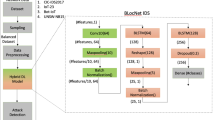Abstract
In recent years, with the growth of the Internet and network devices, a significant amount of information has been exposed to the attackers and intruders. Due to vulnerabilities in the system, the adversaries plan new ways of network intrusions. Many Intrusion Detection Systems (IDSs) are developed to protect the networks from malicious attacks and ensure reliability and availability within the organizations. IDSs built using various machine learning and data mining techniques are effective in detecting attacks. However, their performance decreases with an increase in the size of data. In this paper, we focus on developing an IDS model using Logical Analysis of Data (LAD). It is a supervised learning technique where patterns are generated using partially defined Boolean functions (pdBf), which can detect attacks based on certain features of the data. We compare the performance of LAD model with Deep Neural Network (DNN) and Convolutional Neural Network (CNN) IDS models. UNSW-NB15 and CSE-CIC-IDS2018 datasets are used for training and testing our proposed model. The results show that the performance of LAD model is competitive to CNN, DNN and other existing IDS models based on accuracy, precision, recall and F1 score.
Access this chapter
Tax calculation will be finalised at checkout
Purchases are for personal use only
Similar content being viewed by others
References
CSE-CIC-IDS-2018 dataset from university of newbrunswick. https://www.unb.ca/cic/datasets/ids-2018.html
Almomani, O.: A feature selection model for network intrusion detection system based on PSO, GWO, FFA and GA algorithms. Symmetry 12(6), 1046 (2020). https://doi.org/10.3390/sym12061046
Almuallim, H., Dietterich, T.G.: Learning Boolean concepts in the presence of many irrelevant features. Artif. Intell. 69(1–2), 279–305 (1994). https://doi.org/10.1016/0004-3702(94)90084-1
Basnet, R., Shash, R., Johnson, C., Walgren, L., Doleck, T.: Towards detecting and classifying network intrusion traffic using deep learning frameworks (2019). https://doi.org/10.22667/JISIS.2019.11.30.001
Boros, E., Hammer, P.L., Ibaraki, T., Kogan, A., Mayoraz, E., Muchnik, I.: An implementation of logical analysis of data. IEEE Trans. Knowl. Data Eng. 12(2), 292–306 (2000). https://doi.org/10.1109/69.842268
Crama, Y., Hammer, P.L., Ibaraki, T.: Cause-effect relationships and partially defined Boolean functions. Ann. Oper. Res. 16(1), 299–325 (1988). https://doi.org/10.1007/BF02283750
Das, T.K., Adepu, S., Zhou, J.: Anomaly detection in industrial control systems using logical analysis of data. Comput. Secur. 96, 101935 (2020). https://doi.org/10.1016/j.cose.2020.101935
Das, T.K., Gangopadhyay, S., Zhou, J.: SSIDS: semi-supervised intrusion detection system by extending the logical analysis of data. CoRR (2020). arXiv:2007.10608
Denning, D.: An intrusion-detection model. IEEE Trans. Softw. Eng. SE-13(2), 222–232 (1987). https://doi.org/10.1109/TSE.1987.232894
Fitni, Q.R.S., Ramli, K.: Implementation of ensemble learning and feature selection for performance improvements in anomaly-based intrusion detection systems. In: 2020 IEEE International Conference on Industry 4.0, Artificial Intelligence, and Communications Technology (IAICT), pp. 118–124 (2020)
Hammer, P.L.: Partially defined Boolean functions and cause-effect relationships. In: Proceedings of the International Conference on Multi-Attribute Decision Making via OR-Based Expert Systems. University of Passau (1986)
Kasongo, S.M., Sun, Y.: Performance analysis of intrusion detection systems using a feature selection method on the UNSW-NB15 dataset. J. Big Data 7(1), 1–20 (2020). https://doi.org/10.1186/s40537-020-00379-6
Khammassi, C., Krichen, S.: A GA-LR wrapper approach for feature selection in network intrusion detection. Comput. Secur. 70, 255–277 (2017). https://doi.org/10.1016/j.cose.2017.06.005
Khan, M.A.: HCRNNIDS: hybrid convolutional recurrent neural network-based network intrusion detection system. Processes 9(5) (2021). https://doi.org/10.3390/pr9050834
Kim, J., Shin, Y., Choi, E.: An intrusion detection model based on a convolutional neural network. J. Multimedia Inf. Syst. 6, 165–172 (2019). https://doi.org/10.33851/JMIS.2019.6.4.165
Kim, K., Aminanto, M.E., Tanuwidjaja, H.C.: Network Intrusion Detection Using Deep Learning: A Feature Learning Approach. Springer, Singapore (2018). https://doi.org/10.1007/978-981-13-1444-5
Krishnan, A., Mithra, S.: A modified 1D-CNN based network intrusion detection system. Int. J. Res. Eng. Sci. Manag. 4(6), 291–294 (2021)
Mahmoud, L., Praveen, R.: Artificial neural networks for detecting intrusions: a survey. In: Fifth International Conference on Research in Computational Intelligence and Communication Networks (ICRCICN), pp. 41–48. IEEE (2020)
Mishra, P., Varadharajan, V., Tupakula, U., Pilli, E.S.: A detailed investigation and analysis of using machine learning techniques for intrusion detection. IEEE Commun. Surv. Tutor. 21(1), 686–728 (2018). https://doi.org/10.1109/COMST.2018.2847722
Moustafa, N., Slay, J.: UNSW-NB15: a comprehensive data set for network intrusion detection systems (UNSW-NB15 network data set). In: 2015 Military Communications and Information Systems Conference (MilCIS), pp. 1–6. IEEE (2015). https://doi.org/10.1109/MilCIS.2015.7348942
Moustafa, N., Slay, J.: The evaluation of network anomaly detection systems: statistical analysis of the UNSW-NB15 data set and the comparison with the KDD99 data set. Inf. Secur. J. Glob. Perspect. 25(1–3), 18–31 (2016). https://doi.org/10.1080/19393555.2015.1125974
Moustafa, N., Slay, J., Creech, G.: Novel geometric area analysis technique for anomaly detection using trapezoidal area estimation on large-scale networks. IEEE Trans. Big Data 5(4), 481–494 (2019). https://doi.org/10.1109/TBDATA.2017.2715166
Authors’ Contributions
Conceptualization and Supervision: Sugata Gangopadhyay and Aditi Kar Gangopadhyay. Investigation, Software Implementation of LAD: Sneha Chauhan. Investigation, Software Implementation of CNN and DNN: Loreen Mahmoud. Writing Original Draft: Sneha Chauhan and Loreen Mahmoud.
Author information
Authors and Affiliations
Corresponding authors
Editor information
Editors and Affiliations
Rights and permissions
Copyright information
© 2022 The Author(s), under exclusive license to Springer Nature Switzerland AG
About this paper
Cite this paper
Chauhan, S., Mahmoud, L., Gangopadhyay, S., Gangopadhyay, A.K. (2022). A Comparative Study of LAD, CNN and DNN for Detecting Intrusions. In: Yin, H., Camacho, D., Tino, P. (eds) Intelligent Data Engineering and Automated Learning – IDEAL 2022. IDEAL 2022. Lecture Notes in Computer Science, vol 13756. Springer, Cham. https://doi.org/10.1007/978-3-031-21753-1_43
Download citation
DOI: https://doi.org/10.1007/978-3-031-21753-1_43
Published:
Publisher Name: Springer, Cham
Print ISBN: 978-3-031-21752-4
Online ISBN: 978-3-031-21753-1
eBook Packages: Computer ScienceComputer Science (R0)




